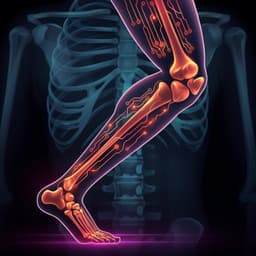
Medicine and Health
Assessment of a proposed BMI formula in predicting body fat percentage among Filipino young adults
M. V. Haute, E. Rondilla, et al.
This study reveals how a modified BMI formula excels at predicting body fat percentage and identifying overweight or obesity in Filipino young adults. Researchers Michael Van Haute, Emer Rondilla, Jasmine Lorraine Vitug, and others explore the promising outcomes of using advanced quadratic models over traditional methods, paving the way for improved health diagnostics.
~3 min • Beginner • English
Introduction
Obesity prevalence has risen globally and is increasing rapidly in Asia, including the Philippines, where overweight and obesity together affect millions of adults and impose substantial healthcare costs. BMI is widely used to screen for adiposity but cannot differentiate fat from lean mass and may misclassify individuals, particularly those who are very short or tall or physically active. L. N. Trefethen proposed a modified BMI formula (BMI = 1.3 × weight[kg] / height[m]^2.5) arguing the conventional BMI underestimates adiposity in short individuals and overestimates it in tall individuals. This study aimed to assess, among Filipino young adults, whether the modified BMI better predicts body fat percentage (%BF) measured by bioelectric impedance analysis and whether it improves diagnosis of overweight/obesity compared with the traditional BMI. A secondary objective was to compare diagnostic accuracy metrics and ROC performance between the two BMI measures.
Literature Review
The paper reviews evidence that BMI correlates with %BF yet is influenced by age, sex, ethnicity, and body composition, leading to misclassification, especially among athletic and stature-extreme individuals. Prior analyses suggest BMI is not independent of height and may underestimate adiposity in short-statured people and overestimate it in tall people. Trefethen’s modification raises height to 2.5 with a scaling factor based on an average adult height of 1.69 m; however, this exponent lacks epidemiologic validation. Literature indicates sex and ethnic differences in the BMI-%BF relationship, with Asians often showing higher %BF and metabolic risk at lower BMIs than Caucasians, motivating lower BMI cutoffs for Asian populations. Studies have suggested a quadratic (curvilinear) relationship between BMI and %BF in some Asian cohorts. Evidence comparing outcomes using traditional versus modified BMI in clinical cohorts (e.g., surgical patients, transplant recipients) has not demonstrated clear advantages of one over the other. Central adiposity, particularly among Asian women, is highlighted as clinically relevant.
Methodology
Design: Cross-sectional observational study conducted during the second semester of academic year 2018–2019 at De La Salle Medical and Health Sciences Institute (DLSMHSI), Cavite, Philippines; ethics approval obtained.
Population and recruitment: Medical students at DLSMHSI (study population N=783). Inclusion: Filipino descent, age 18–35 years, volunteer participation. Exclusion: chronic illness (e.g., diabetes, hypertension, heart failure, malignancy), recent MI or stroke (past 6 months), pregnancy, chronic corticosteroid use, posture-affecting conditions (kyphosis, scoliosis, kyphoscoliosis), or active bodybuilding/exercise program. Recruitment via classroom visits; informed consent obtained; no incentives.
Sample: 190 participants enrolled (74 males, 116 females).
Measurements: Data collected by interview and direct measurement in scheduled batches. Equipment calibrated regularly. Height measured with stadiometer to 0.1 cm; weight and %BF via Tanita BC-543 bioelectrical impedance analyzer to 0.1 kg and 0.1% respectively; waist circumference (WC) measured at midpoint between last palpable rib and iliac crest to 0.1 cm. Participants fasted from food/fluids for ≥2 hours before BIA. Smoking history recorded as pack-years; alcohol intake as average drinks/week.
BMI calculations and classifications: Traditional BMI (BMI_K) = weight[kg]/height[m]^2; modified BMI (BMI_T per Trefethen) = 1.3 × weight[kg]/height[m]^2.5. Asian-Pacific BMI categories applied: underweight <18.5; normal 18.5–22.9; overweight 23.0–24.9; obese ≥25.0. %BF thresholds to define overweight/obese by adiposity: males ≥25%; females ≥35%.
Statistical analysis: Normality via Shapiro–Wilk. Between-sex comparisons with t-test or Mann–Whitney U as appropriate; proportions by chi-square. Differences between BMI_K and BMI_T medians assessed in bottom and top 10% of height distribution via Mann–Whitney U. Correlations (Pearson/Spearman) computed among BMI_K, BMI_T, and %BF. Agreement in BMI-based weight categories via Cohen’s kappa. Predicting %BF: sex-specific robust polynomial regression models (Huber–White robust SEs) with linear and quadratic terms; covariates: age, WC, smoking, alcohol; quadratic models included BMI^2. Wald test assessed necessity of squared term. Model adequacy: assessment of linearity (including LOWESS), error independence, model specification, omitted variable tests; AIC and BIC for model comparison. Missing data handled by chained multiple imputation (predictive mean matching). Diagnostic accuracy: sex-specific ROC curves for identifying overweight-obese by %BF; sensitivity, specificity, PPV, NPV, LR+ and LR− computed; optimal BMI cutoffs via Youden index. Post-hoc power analyses performed in R; other analyses in Stata 15; significance at p<0.05 with 95% CIs.
Key Findings
- Sample: 190 participants (74 males, 116 females), median age 22 years (range 19–30). Only 1.6% (3 males) were current smokers; 15.3% reported ≥1 drink/week (19 males, 10 females; p=0.0014).
- Sex differences: Males had higher height, weight, WC, BMI_K and BMI_T (all p<0.001); females had higher %BF (p<0.001). By %BF thresholds, 28/74 males (37.8%) had ≥25% BF; 21/116 females (18.1%) had ≥35% BF.
- BMI_T vs BMI_K by height extremes (Table 2): In bottom 10% of height, BMI_T < BMI_K (males median diff −0.9; females −1.9). In top 10%, BMI_T > BMI_K slightly (males +0.7; females +0.1). Differences were not statistically significant.
- Correlations with %BF (Table 3): BMI_T and BMI_K highly correlated (males r=0.997; females r=0.995). Correlations with %BF were high: males BMI_T r=0.785 (95% CI 0.677–0.860), BMI_K r=0.782 (0.672–0.858); females BMI_T r=0.833 (0.769–0.883), BMI_K r=0.815 (0.745–0.870).
- Agreement of BMI-based weight categories (Table 4): Males: 96.0% agreement (95% CI 91.5–100.0%), κ=0.9306 (95% CI 0.7658–1.0000). Females: 81.0% agreement (95% CI 73.9–88.2%), κ=0.7139 (95% CI 0.5969–0.8309).
- Regression modeling (Tables 5–6): Wald tests supported inclusion of the squared BMI term (males F=4.81 for BMI_T and 4.23 for BMI_K; females F=16.37 and 14.81; all p≤0.044). Quadratic models outperformed linear models for both sexes (higher adjusted R^2, lower AIC/BIC). Adjusted R^2: males BMI_K linear 0.5938 vs quadratic 0.6300; males BMI_T linear 0.5930 vs quadratic 0.6205. Females BMI_K linear 0.7478 vs quadratic 0.8094; females BMI_T linear 0.7442 vs quadratic 0.7935. In females, both BMI and WC were significant predictors of %BF; in males, BMI terms were significant while WC was not. BMI^2 coefficients were negative and significant in all sex-specific quadratic models, consistent with a curvilinear relationship.
- Diagnostic accuracy using BMI cutoff 23.0 (Table 7): High sensitivity and NPV but modest specificity and PPV. BMI_K: males sensitivity 100% (87.7–100%), specificity 44.4% (29.6–60.0%), PPV 58.2% (38.6–66.7%), NPV 100% (83.2–100%), LR+ 1.77, LR− 0.039; females sensitivity 95.2% (69.5–99.9%), specificity 69.5% (59.2–78.5%), PPV 40.8% (27.0–55.8%), NPV 98.5% (92.0–100%), LR+ 3.03, LR− 0.098. BMI_T: males sensitivity 100% (87.7–100%), specificity 46.7% (31.7–62.1%), PPV 53.8% (39.5–67.8%), NPV 100% (83.9–100%), LR+ 1.85, LR− 0.037; females sensitivity 95.2% (76.2–99.9%), specificity 62.1% (51.6–71.9%), PPV 35.7% (23.4–49.6%), NPV 98.3% (91.1–100%), LR+ 2.45, LR− 0.11.
- Optimal BMI cutoffs (Youden): For %BF-defined overweight/obese, optimal BMI_K cutoffs were 26.7 (males; Sn 96%, Sp 91%) and 25.1 (females; Sn 90%, Sp 89%); optimal BMI_T cutoffs were 26.3 for both sexes (males Sn 100%, Sp 87%; females Sn 86%, Sp 89%).
- ROC performance (Figure 2): High AuROCs for both indices. Males: BMI_K AUROC 0.9706 (95% CI 0.9286–1.0000); BMI_T 0.9675 (0.9245–1.0000). Females: BMI_K 0.9378 (0.8928–0.9829); BMI_T 0.9238 (0.8685–0.9791). Differences between BMI_K and BMI_T AuROCs were not statistically significant. Post-hoc power for comparing AuROCs was low (24.45% males; 10.96% females).
Discussion
Both the traditional BMI and Trefethen’s modified BMI strongly correlate with %BF and significantly predict %BF in Filipino young adults. The %BF–BMI relationship is better captured by quadratic models than linear ones, consistent with prior work in Asian populations, reflecting possible ethnic/body composition differences and greater adiposity at lower BMIs. Diagnostic performance for identifying %BF-defined overweight/obesity is excellent when optimal, sex-specific BMI cutoffs are used, whereas applying a BMI cutoff of 23.0 yields high sensitivity and NPV but relatively poor specificity and PPV, especially in males and in females’ PPV. Height-related behavior of BMI_T versus BMI_K followed expectations (BMI_T relatively lower among the shortest and higher among the tallest), though differences were nonsignificant in this sample. Agreement between BMI-based classifications was almost perfect in males and substantial in females, with more reclassification among females. WC added predictive value in females, aligning with higher central adiposity patterns reported in Asian women. While AuROCs were high and similar between BMI_K and BMI_T, the study was underpowered to detect small differences between them, so equivalence in diagnostic accuracy cannot be concluded. Findings underscore that BMI, even when modified, does not resolve the limitation of distinguishing lean from fat mass and support reevaluating BMI cutoffs tailored to population risk profiles.
Conclusion
In Filipino young adults, both the traditional and modified (Trefethen) BMI significantly predict body fat percentage and can adequately discriminate between %BF-defined normal and overweight–obese states when using optimal BMI cutoffs. However, specificity remains limited, reflecting BMI’s inability to differentiate lean from fat mass. Given observed reclassification patterns—especially in individuals below 1.69 m—future prospective studies should assess whether modified BMI–based reclassification affects long-term health outcomes. Additional research should validate optimal BMI cutoffs for Asian populations, examine country-specific calibration concepts, and compare long-term prognostic performance of BMI_K versus BMI_T in diverse cohorts.
Limitations
- Voluntary participation may introduce self-selection bias and overrepresent overweight/obese categories relative to national prevalence; PPV/NPV were adjusted for sample prevalence.
- Sample size smaller than target; while adequately powered for regression modeling, the study was underpowered to detect differences between BMI_K and BMI_T AuROCs.
- Restricted to young, nonathletic Filipino medical students without chronic diseases; results are not generalizable to older adults, physically active occupational groups, or non-Filipino populations.
- Potential unmeasured confounding remains despite inclusion of age, WC, smoking, and alcohol.
- %BF measured by bioelectrical impedance analysis rather than DXA; although suitable for epidemiologic use with proper preparation, BIA is not the gold standard.
- Construction and validation of individualized or country-specific BMI formulae were beyond scope and would require additional empirical data.
Related Publications
Explore these studies to deepen your understanding of the subject.







